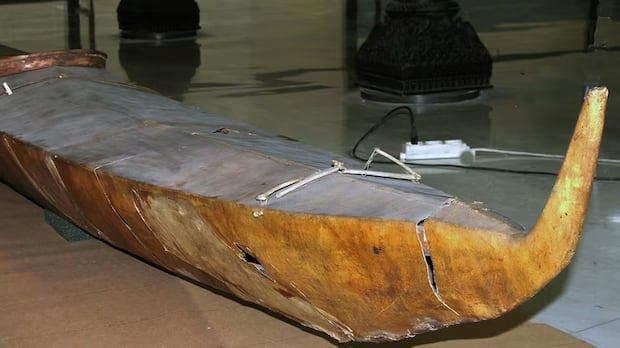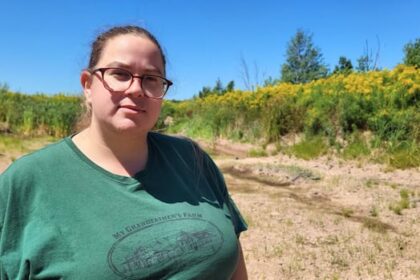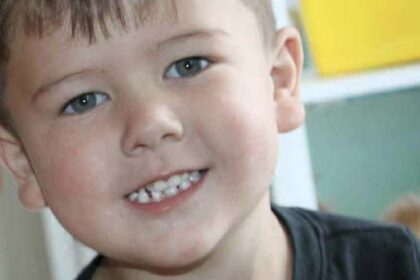NewsA century-old Inuvialuit kayak once used for beluga and whale hunts, and 61 other cultural objects from First Nations, Métis and Inuit communities have long been held in Vatican Museums vaults. But the items will be returned to Canada on Dec. 6 after Pope Leo on Saturday gifted them to a delegation of Catholic bishops. Pope Leo ‘desires that this gift represent a concrete sign of dialogue, respect and fraternity,’ Vatican saysMegan Williams · CBC News · Posted: Nov 15, 2025 5:56 AM EST | Last Updated: 1 hour agoListen to this articleEstimated 4 minutesThe audio version of this article is generated by text-to-speech, a technology based on artificial intelligence. This Inuvialuit kayak is part of dozens of Indigenous cultural items from Canada that were being held at the Vatican Museums, but on Saturday were gifted by Pope Leo to the Canadian Conference of Catholic Bishops, with the aim of having them returned to various communities. (Submitted by Ken Lister)A century-old Inuvialuit kayak once used for beluga and whale hunts, and 61 other cultural objects from First Nations, Métis and Inuit communities have long been held in Vatican Museums vaults. But the cultural items will be returned to Canada on Dec. 6 after Pope Leo XIV gifted them to the Canadian Conference of Catholic Bishops (CCCB) on Saturday, said a joint statement by the Vatican and the conference.The announcement was made following a meeting at the Holy See between the Pope and a CCCB delegation, including its president, Bishop Pierre Goudreault, Rev. Richard Smith, archbishop of Vancouver, and Rev. Jean Vézina, general secretary.“At the conclusion of the journey initiated by Pope Francis that included his apostolic journey to Canada in 2022, various audiences with Indigenous communities and the publication of the Declaration on the Doctrine of Discovery in 2023, His Holiness Pope Leo XIV desires that this gift represent a concrete sign of dialogue, respect and fraternity,” the statement said.It also said the Pope has given the objects to the CCCB, who “are committed to ensuring that these artifacts are properly safeguarded, respected and preserved.””The CCCB will proceed, as soon as possible, to transfer these artifacts to the National Indigenous Organizations (NIOs). The NIOs will then ensure that the artifacts are reunited with their communities of origin,” the Canadian bishops said.Indigenous artifacts held in Vatican Museums finally heading back to CanadaThe negotiations were led by Indigenous groups and had been ongoing for two years. The expense of the negotiations and the return of the cultural objects to date have been prepaid by Indigenous groups. Joyce Napier is Canadian ambassador to the Holy See who was part of the Canadian government effort to help repatriate the cultural items.Calling the return of the items a “historic day,” Napier added, “There have been many conversations with the Vatican and CCCB, and it was clear the Vatican wished to return the objects,” with Pope Francis’s illness and death temporarily slowing the negotiations, she added.Napier said the items, now in vaults inside the Vatican Museums, will be packaged in crates and flown to Montreal via Frankfurt on an Air Canada flight set to arrive on Dec. 6. From there, they will be shipped to the Canadian Museum of History in Gatineau, Que., where experts will assess their condition, confirm their origins and work with Indigenous representatives to decide where they should ultimately end up.Pope Leo delivers a speech at the Pontical Lateran University in Rome on Friday. The next day, the Pope gifted the Indigenous cultural objects from Canada to a delegation of Catholic bishops. (Alessandra Tarantino/The Associated Press)After years of calls for repatriation, the move is being seen as a significant step for Indigenous communities where for decades children were taken from their families and forced to attend Catholic Church-run residential schools, where abuse was rampant.Canadian Foreign Affairs Minister Anita Anand also welcomed the move.”This is an important step that honors the diverse cultural heritage of Indigenous peoples and supports ongoing efforts toward truth, justice, and reconciliation,” Anand wrote on X, formerly Twitter.The return of the items is structured as a church-to-church “gift,” which Vatican spokesperson Matteo Bruni said is the how the Vatican gives back cultural objects, allowing it to avoid setting a precedent of returning items directly to nations or communities.In 2023, a year after Pope Francis’s “penitential” trip to Canada when he apologized for some members of the Catholic Church’s role in residential schools, Francis acknowledged the importance of restitution of the items, many considered sacred by some First Nations. During meetings in Italy, Canada’s prime minister at the time, Justin Trudeau, and later Foreign Minister Mélanie Joly pressed the Pope and the Vatican secretary of state to return the cultural objects.Thread-embroidered gloves, attributed to the Cree from Canada’s central sub-Arctic, on display at the Vatican Museums along with other Indigenous items. (Submitted)The kayak was among 100,000 objects originally sent to Rome in 1925 for a world exhibition organized by Pope Pius XI, who invited Catholic missionaries to ship “examples of Indigenous life” from the regions where the men worked. Other notable items include a wampum belt from Kanesatake, Que., that was “donated” to Pope Gregory XVI in 1831, embroidered leather gloves of Cree origin and a Gwich’in baby belt.Many of the objects came from Indigenous communities during a period of forced conversion, cultural suppression and the residential school system in Canada, and most remained inside Vatican Museums storage rooms.Indigenous leaders stress that ceremonies must take place before the items make the journey home.Some have criticized the “church-to-church” approach and insisted communities be directly involved in identifying the items. With files from Reuters
Saturday, 15 Nov 2025
Canada – The Illusion
Search
Have an existing account?
Sign In
© 2022 Foxiz News Network. Ruby Design Company. All Rights Reserved.
You May also Like
- More News:
- history
- Standing Bear Network
- John Gonzalez
- ᐊᔭᐦᑊ ayahp — It happened
- Creation
- Beneath the Water
- Olympic gold medal
- Jim Thorpe
- type O blood
- the bringer of life
- Raven
- Wás’agi
- NoiseCat
- 'Sugarcane'
- The rivers still sing
- ᑲᓂᐸᐏᐟ ᒪᐢᑿ
- ᐅᑳᐤ okâw — We remember
- ᐊᓂᓈᐯᐃᐧᐣ aninâpêwin — Truth
- This is what it means to be human.
- Nokoma












